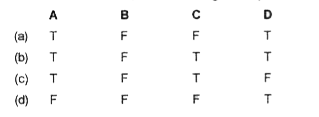In male cockroach, a pair of testis are located one on each lateral side in the abdominal segment -
6th - 10th
6th-8th
4th - 6th
10th - 12th
The correct Answer is:C
To answer the question regarding the location of the testes in male cockroaches, we can follow these steps:
1. Understand the Male Reproductive System of Cockroach:
- The male cockroach has a pair of testes, which are responsible for producing sperm.
2. Identify the Location of Testes:
- The testes are located on each lateral side of the body. This means that one testis is found on the left side and the other on the right side.
3. Determine the Abdominal Segments:
- The question asks for the specific abdominal segments where these testes are located.
- In male cockroaches, the testes are situated in the abdominal segments.
4. Select the Correct Segment Range:
- The options provided are:
- A) 6th to 10th
- B) 6th to 8th
- C) 4th to 6th
- D) 10th to 12th
- Based on biological studies, the testes of male cockroaches are located in the 4th to 6th abdominal segments.
5. Conclude the Answer:
- Therefore, the correct answer is C) 4th to 6th.
- The male cockroach has a pair of testes, which are responsible for producing sperm.
- The testes are located on each lateral side of the body. This means that one testis is found on the left side and the other on the right side.
- The question asks for the specific abdominal segments where these testes are located.
- In male cockroaches, the testes are situated in the abdominal segments.
- The options provided are:
- A) 6th to 10th
- B) 6th to 8th
- C) 4th to 6th
- D) 10th to 12th
- Based on biological studies, the testes of male cockroaches are located in the 4th to 6th abdominal segments.
- Therefore, the correct answer is C) 4th to 6th.
Similar Questions
Consider the following statements (A - D) related to Periplaneta americana and select the correct option stating which ones are true (T) and which ones are false (F).
Statements :
A. In male cockroach, 10th segment bears a pair of short, thread like anal styles which are absent in female.
B. The first pair of wings arise from mesothorax and are used in flight.
C. Opening of 10 pairs abdominal spiracles is regulated by sphincters.
D. In male cockroach, a mushroom gland is present in the 6th - 7th abdominal segments.
 View Solution
View SolutionA pair of male genital pores in earthworm are present on the ventro-lateral sides of the
View Solution
Knowledge Check
- Question 1 - Select One
The ovaries of cockroach are located in the abdominal segments -
A2−6B5−6C1−2D5−6 - Question 2 - Select One
In Earthworm, testes occur in segments
A10 and 11B12 and 13C14 and 15D17 and 18 - Question 3 - Select One
Read the following statements about cockroach.
(i) In male cockroach, a characteristic mushroom shaped gland is present in the 6th - 7th abdominal segments which functions as an accessory reproductive gland.
(ii) Cockroach is uricotelic
(iii) The fat body and uricose glands are glandular in function.
(iv) Blood from sinuses enter heart through ostia and is pumped anteriorly to issunses again.
Which of the above statements are correct ?A(i), (ii) and (iv)B(ii) and (iii)C(i) and (iv)D(ii) and (iv)
How many pairs of testis are present in human male?
View SolutionTestes occur in Cockroach in abdominal segments
View SolutionRead the following statements about cockroach
(i) In male cockroach, a characteristic mushroom shaped gland is present in the 6th−7th abdominal segments which functions as an accessory reproductive gland
Cockroach is uricotelic
(iii) The fat body and uricose glands are glandular in function
(iv) Blood from sinuses enter heart through ostia and is pumped anteriorly to sinuses again.
Which of the above statements are correct ?View SolutionIn male cockroach, from each testis arises a thin vas deferens, which open into through seminal vesicle -
View SolutionMushroom gland in cockroach is located in
View Solution

